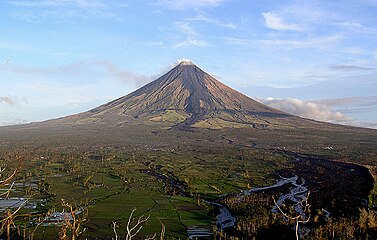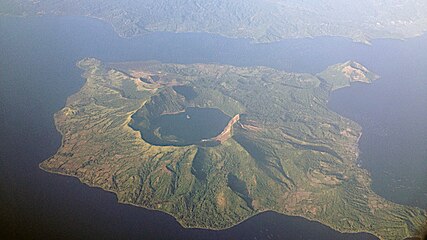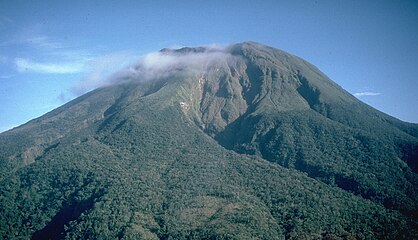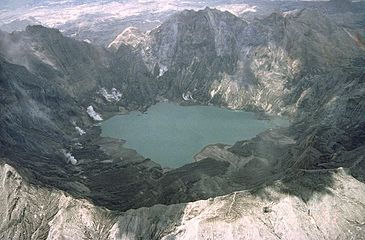As of 2018, the Philippines has 24[1] volcanoes listed as active by the Philippine Institute of Volcanology and Seismology (PHIVOLCS). Twenty-one of these have had historical eruptions. The three exceptions are Cabalian, which is a strongly fumarolic volcano;[further explanation needed] Leonard Kniaseff, which was active 1,800 years ago (C14),[2] and Isarog, which last erupted around 3500 BCE and 2374 BCE ± 87 based on radiocarbon dating[3][4][5]
Volcanoes in the country have erupted within the last 600 years, with accounts of these eruptions documented by humans; or have erupted within the last 10,000 years (Holocene). There are 100 volcanoes in the Philippines listed by the Smithsonian Institution's Global Volcanism Program (GVP) at present,[6] of which 20 are categorized as "historical" and 59 as "Holocene".[6] The GVP lists volcanoes with historical, Holocene eruptions, or possibly older if strong signs of volcanism are still evident through thermal features like fumaroles, hot springs, mud pots, etc.[7]
List of volcanoes
[edit]The list below showing 27 active volcanoes in the Philippines was based on the PHIVOLCS list with some included from the GVP. The number is not definite and depends on someone's definition of "active" or historical time frame. Descriptions under "eruptions" were based on the GVP website. The frequency of historical eruptions excludes questionable or uncertain accounts based on the two sources mentioned.
| Name | Elevation (ASL)[2] | Coordinates | Province(s)[2] | Eruptions[2] | ||
|---|---|---|---|---|---|---|
| m | ft | Description and current status | ||||
| Ambalatungan Group | 2,329 | 7,641 | 17°18′40″N 121°06′13″E / 17.310982°N 121.103668°E | Kalinga | 0 | Explosions in 1952 is uncertain.[8] Fumarolic with solfataras and thermal springs. |
| Babuyan Claro | 843 | 2,766 | 19°31′23″N 121°56′24″E / 19.523°N 121.940°E | Cagayan | 3 | Eruptions were recorded in 1831, 1860 and 1913. Askedna Hot Springs is in the southern base of the volcano. |
| Banahaw | 2,169 | 7,116 | 14°04′N 121°29′E / 14.07°N 121.48°E | Laguna, Quezon | 4 | Eruptions were uncertain during the mudflows of 1730, 1743, 1843 and 1909.[9] |
| Biliran | 1,340 | 4,400 | 11°33′29″N 124°30′47″E / 11.558°N 124.513°E | Biliran | 1 | Phreatic eruption in 1939. Fumarolic with thermal springs |
| Bulusan | 1,565 | 5,135 | 12°46′12″N 124°03′00″E / 12.770°N 124.05°E | Sorsogon | 17 | Eruptions years are from 1886 to 2022. Permanently monitored |
| Cabalian[2] | 945 | 3,100 | 10°17′13.2″N 125°13.25′0″E / 10.287000°N 125.22083°E | Southern Leyte | 1 | Radiocarbon dating on a pyroclastic flow deposit from the volcano estimated that the last eruption was in 1820 |
| Cagua | 1,160 | 3,810 | 18°13′19″N 122°07′23″E / 18.222°N 122.123°E | Cagayan | 1 | Eruption in 1860 and strong solfataric activity in 1907. Thermal areas are near the summit and NW to NNE flanks. |
| Camiguin de Babuyanes | 712 | 2,336 | 18°49′48″N 121°51′36″E / 18.83°N 121.860°E | Cagayan | 1 | Its only recorded eruption was in 1857. Fumarolic with thermal springs |
| Didicas | 843 | 2,766 | 19°04′37″N 122°12′07″E / 19.077°N 122.202°E | Cagayan | 6 | Eruptions in 1773, 1856, 1900, 1952, 1969 and 1978. A submarine volcano till 1952 when a permanent island was formed.[10] |
| Hibok‑Hibok | 1,332 | 4,370 | 9°12′11″N 124°40′23″E / 9.203°N 124.673°E | Camiguin | 5 | Eruption in years 1827, 1862, 1871 and 1948–1952. Activity from 1897–1902 was only solfataric. Permanently monitored. |
| Iraya | 1,009 | 3,310 | 20°28′08″N 122°00′36″E / 20.469°N 122.010°E | Batanes | 1 | Last eruption was in 1454. Seismic swarm in 1998. |
| Iriga | 1,143 | 3,750 | 13°27′25″N 123°27′25″E / 13.457°N 123.457°E | Camarines Sur | 0 | The eruption in 1628 was discredited.[11] |
| Isarog | 1,143 | 3,750 | 13°39′29″N 123°22′48″E / 13.658°N 123.38°E | Camarines Sur | 2 | The last eruption was around 3500 BCE ± 125 years and 2374 BCE ± 87 years based on radiocarbon dating.[12][13][14] |
| Jolo Group | 620 | 2,030 | 6°00′47″N 121°03′25″E / 6.013°N 121.057°E | Sulu | 0 | Uncertain submarine eruption in 1897. Listed as Bud Dajo, a cinder cone on Jolo Island, in the PHIVOLCS list. |
| Kanlaon | 2,435 | 7,989 | 10°24′43″N 123°07′55″E / 10.412°N 123.132°E | Negros Occidental, Negros Oriental | 27 | Eruptions were recorded from 1886 to 2006. On November 23, 2015 the volcano had a small, steam-driven explosion. PHIVOLCS raised the alert level to 1 (mild restiveness). Last eruption was on June 03, 2024 which PHIVOLCS classified as phreatic eruption. Kanlaon ejected about 5 kilometers high column of ash and incandescent materials. Prevalent rains further caused lahar in areas located at the foot of the volcano. Permanently monitored. |
| Leonard Kniaseff | 200 | 660 | 7°22′55″N 126°02′49″E / 7.382°N 126.047°E | Davao de Oro | 0 | Last eruption was dated as c.120 AD.[15] Strong thermal features. |
| Makaturing | 1,940 | 6,360 | 7°38′49″N 124°19′12″E / 7.647°N 124.32°E | Lanao del Sur | 2 | Eruption recorded in 1865 and 1882. The 1856 and 1858 eruptions was credited to Ragang[16][17] |
| Matutum | 2,286 | 7,500 | 6°22′N 125°04′E / 6.37°N 125.07°E | South Cotabato | 0 | Mountain was fumarolic on March 7, 1911, but if an eruption occurred was uncertain. Thermal springs in Akmoan and Linan.[18][19] |
| Mayon | 2,460 | 8,070 | 13°15′25″N 123°41′06″E / 13.257°N 123.685°E | Albay | 54 | Eruptions were recorded from 1616 to 2023. Permanently monitored. Most recent major volcanic activity occurred in 2023. |
| Mélébingóy | 1,784 | 5,853 | 6°06′47″N 124°53′31″E / 6.113°N 124.892°E | South Cotabato | 1 | A caldera-forming eruption occurred on January 4, 1641. |
| Musuan | 646 | 2,119 | 7°52′37″N 125°04′05″E / 7.877°N 125.068°E | Bukidnon | 2 | Eruptions in 1866 & 1867. Strong seismic swarm in 1976. |
| Pinatubo | 1,445 | 4,741 | 15°08′N 120°21′E / 15.13°N 120.35°E | Zambales, Tarlac, Pampanga | 4 | Reawakened in 1991, producing the 2nd largest eruption in the 20th century. Followed by milder eruptions in 1992 and 1993. Also minor additional activities in 2021. Permanently monitored. |
| Ragang | 2,815 | 9,236 | 7°42′N 124°30′E / 7.70°N 124.50°E | Lanao del Sur, Cotabato | 7 | Eruption years are from 1765 to 1873. Eruptions were uncertain in 1915 and 1916. |
| San Pablo Volcanic Field | 1,090 | 3,580 | 14°07′N 121°18′E / 14.12°N 121.30°E | Laguna, Batangas | 1 | Last activity was the formation of Sampaloc Lake around 1350 AD +/- 100 years determined by anthropology[7][20] |
| Smith | 688 | 2,257 | 19°32′02″N 121°55′01″E / 19.534°N 121.917°E | Cagayan | 6 | Eruption years are from 1652 to 1924. Combined with Babuyan Claro on the GVP list. |
| Taal | 311 | 1,020 | 14°00′07″N 120°59′35″E / 14.002°N 120.993°E | Batangas | 39 | Previous eruption years are from 1572 to 1977. Currently having an ongoing unrest erupting. Permanently monitored. |
| Unnamed volcano (Ibugos) |
−24 | −79 | 20°20′N 121°45′E / 20.33°N 121.75°E | Batanes | 3 | Submarine eruptions in 1773, 1850, and 1854. |
Gallery
[edit]-
Mount Mayon in Albay the most active volcano in the Philippines
-
Mount Melibengoy and its crater lake in South Cotabato
See also
[edit]- List of potentially active volcanoes in the Philippines
- List of inactive volcanoes in the Philippines
- List of mountains in the Philippines
References
[edit]- ^ Philippine Institute of Volcanology and Seismology. "Volcanoes of the Philippines". Retrieved June 16, 2021.
- ^ a b c d e "List of Active Volcanoes". Philippine Institute of Volcanology and Seismology (PHIVOLCS). July 30, 2008. Archived from the original on March 4, 2016.
- ^ Smithsonian Institution. "Isarog". Retrieved June 16, 2021.
- ^ Admin, Bicolmail Web (September 16, 2022). "It is official: Mt. Isarog is active". bicolmail. Retrieved October 8, 2022.
- ^ Daita, Timothy John E. (January 1, 2020). "Paleomagnetic determination of pyroclastic density current deposits in Tagongtong and Bagumbayan Grande, Goa, Camarines Sur, Philippines and the identification of Isarog volcano's latest eruption age". Virtual GeoCon.
- ^ a b "Volcanoes of the Philippines and Southeast Asia". Global Volcanism Program. Smithsonian Institution. Retrieved August 18, 2011.
- ^ a b "Volcano Data Criteria". Global Volcanism Program. Smithsonian Institution. Retrieved August 18, 2011.
- ^ "Eruption History, Ambalatungan Group". Global Volcanism Program. Retrieved on August 18, 2011.
- ^ "Banahaw Eruption History". Global Volcanism Program. Retrieved on August 18, 2011.
- ^ "Didicas Eruption History". Global Volcanism Program. Retrieved on August 18, 2011.
- ^ "Iriga Eruption History". Global Volcanism Program. Retrieved on August 18, 2011.
- ^ Smithsonian Institution. "Isarog". Retrieved June 16, 2021.
- ^ Admin, Bicolmail Web (September 16, 2022). "It is official: Mt. Isarog is active". bicolmail. Retrieved October 8, 2022.
- ^ Daita, Timothy John E. (January 1, 2020). "Paleomagnetic determination of pyroclastic density current deposits in Tagongtong and Bagumbayan Grande, Goa, Camarines Sur, Philippines and the identification of Isarog volcano's latest eruption age". Virtual GeoCon.
- ^ "Leonard Range Eruption History". Global Volcanism Program. Retrieved on August 18, 2011.
- ^ "Makaturing Eruption History". Global Volcanism Program. Retrieved on August 18, 2011.
- ^ "Makaturing". Global Volcanism Program. Retrieved on August 18, 2011.
- ^ "Matutum". Global Volcanism Program. Retrieved on August 18, 2011.
- ^ "Matutum Eruption History". Global Volcanism Program. Retrieved on August 18, 2011.
- ^ "San Pablo Volcanic Field Eruption History". Global Volcanism Program. Retrieved on August 18, 2011.
External links
[edit]Geography of the Philippines | ||
|---|---|---|
| Geology | ||
| Landforms | ||
| Water | ||
| Seas | ||
| Environment | ||
| Active volcanoes |
| ||||||
|---|---|---|---|---|---|---|---|
| Potentially active volcanoes | |||||||
See also: List of mountains in the Philippines | |||||||
| Sovereign states |
|
|---|---|
| States with limited recognition |
|
| Dependencies and other territories |
|










